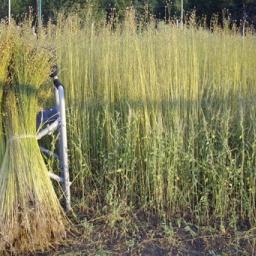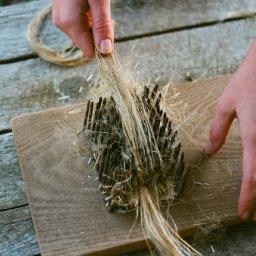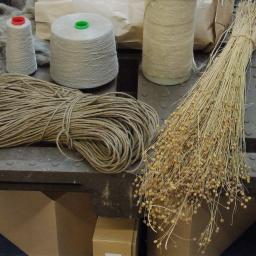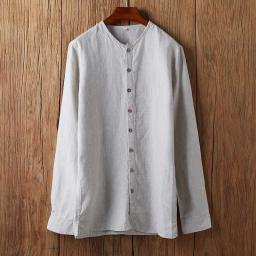How to grow your own Linen
Linen has been used for thousands of years for clothes, bedding and furnishings. It is loved for its soft and cool feel. It is a very strong and durable material which will last much longer than other alternatives, like cotton. Growing your own linen may see overwhelming, but it helps to break it down into manageable steps.
Plant 1 kg. fibre flax seed in a 6m x 6m plot - One plot will give you enough fibre to make a shirt from line (long linen fibres) and tow to weave a couple of towels. Your actual yield will depend on growing conditions, how well you weed the plot and how perfect your retting and hackling techniques are.
Broadcast the seed thickly, over well tilled ground and then walk on it to firm the seed in.
Weed it well about 4 weeks after planting - Your flax will take about 2 weeks to germinate in a cool, wet spring. When it reaches just over 5cm in height you should walk into the plot and weed it well. You can step on the plants without damaging them when they are between 5cm and 30cm tall.
Admire the blue flax flowers as the linen grows - Once the bed has been weeded well, you can just admire it as it grows. About 60 days from planting the flowers start to open. It is very beautiful watching the blue flowers swaying in the breeze. Each flower is open for only one day. Each stock produces several flowers and each flower turns into a seed boll with 6 to 8 seeds.
100 days after planting, harvest the flax - The stocks of flax will be 2/3rds yellow and 1/3rd still green when it is ready to harvest. The flowering will be finished and each slender flax plant will have 4 to 6 seed bolls. You harvest the flax by hand, by pulling each plant out by the roots. Toss the weeds and place the stems of flax in order. Tie into bundles (shooks) about 30cm across, using strong twine.
Shook the flax and wait -Take the shooks of flax and put them, standing upright, under cover to finish maturing the seed and drying the fibre. The whole stock will turn brown as it dries. This takes a month in dry weather, a bit longer in wet weather.
Ripple the flax - Open each bundle of flax, take the flax by the root end and draw the seed end through wide toothed combs or a board with nails acting as teeth. This removes the seed heads. You can begin the retting process now or retie the bundles and wait till Spring.
The seed is edible and has a good oil content. You can crush the seed bolls and separate the seeds from the chaff by winnowing. Save about 1 kg. of seed to replant the field next year. If you don’t want to clean the seed by winnowing, you can feed it to your back yard chickens. They will take care of the seed bolls for you.
See our website for the full tutorial with pictures: www.curtainclean.co.nz...
Neighbourhood Challenge: Who Can Crack This One? ⛓️💥❔
What has a head but no brain?
Do you think you know the answer? Simply 'Like' this post if you know the answer and the big reveal will be posted in the comments at 2pm on the day!
Want to stop seeing these in your newsfeed?
Head here and hover on the Following button on the top right of the page (and it will show Unfollow) and then click it. If it is giving you the option to Follow, then you've successfully unfollowed the Riddles page.

Some Choice News!
Many New Zealand gardens aren’t seeing as many monarch butterflies fluttering around their swan plants and flower beds these days — the hungry Asian paper wasp has been taking its toll.
Thanks to people like Alan Baldick, who’s made it his mission to protect the monarch, his neighbours still get to enjoy these beautiful butterflies in their own backyards.
Thinking about planting something to invite more butterflies, bees, and birds into your garden?
Thanks for your mahi, Alan! We hope this brings a smile!

Creative Spaces for Tweens
Support your child’s growth and well being with our tweens art therapy sessions. Designed for 9–12-year-olds, including home-schooled children or those finding school challenging, these sessions provide a safe, supportive space to explore creativity, express emotions, and build confidence. Through fun, hands-on activities and guided skill-building, our tweens art therapy helps young people develop resilience, social connection, and self-expression.
Whether your child is not currently attending school or simply needs a peaceful, encouraging environment, tweens art therapy offers meaningful experiences that promote growth, friendship, and well being. Join us and help your child thrive in a welcoming, supportive space with tweens art therapy.
Book now at www.artsforhealth.co.nz...











 Loading…
Loading…